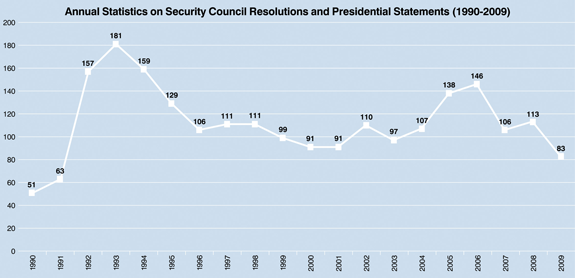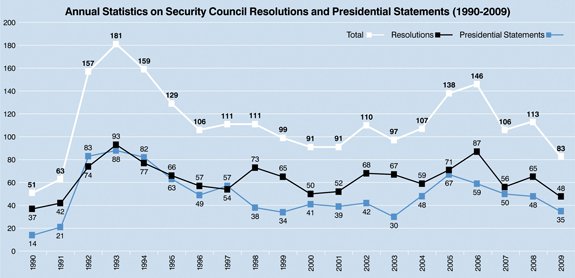Security Council Statistics for 2009
Reduced Security Council Decision Making in 2009: A Year of Decline – Or are the Statistics Misleading?
The year 2009 has seen a dramatic drop in the level of Security Council decisions. Output has reduced to levels not seen since 1991. The following chart demonstrates graphically the overall situation. This report gives a breakdown of the figures. It also analyses some of the underlying factors which may have influenced this situation.

Council Decisions and Activity
In 2009 the total number of Council decisions (resolutions and presidential statements) decreased by 26 percent from 2008. The number dropped from 113 to 83, the lowest level since 1991. Resolutions dropped from 65 to 48 and presidential statements from 48 to 35.
This significant trend is also mirrored in a matching reduction in formal Council activity. The number of formal Council meetings decreased by 20 percent, from 243 to 194.
The number of press statements, which is one indicator of Council decision making at the informal level, also decreased by 23 percent, from 47 to 36.

Some examples of this reduced Council activity in specific cases can be seen in the numbers of formal meetings on:
-
Somalia (down from 16 to 11); and
-
Sudan (down from 22 to 16).
There was also a decrease in Council decisions on thematic issues, although the decline was less marked. The number of thematic resolutions dropped by 17 percent compared to 2008 (from 12 to 10) and the number of presidential statements on thematic issues fell from 18 to 11.
On counter-terrorism Council decisions also decreased. In 2009 only one resolution was adopted as opposed to three in 2008. There were four presidential statements condemning terrorist incidents in 2009 down from five in 2008. The number of press statements issued in response to terrorist incidents also declined, from 15 to 10.
Four resolutions were passed relating to the International Criminal Tribunals for the former Yugoslavia and Rwanda as opposed to five in 2008.
Background
Since the end of the Cold War the Council has had two periods of very intense activity: 1992-1996 and 2004-2008. In these periods the average level of decision making was 134 decisions per year.
In the intervening period, 1997-2003, the average level of decision making was lower—but still averaged at least 100 decisions per year. The change in 2009, down to a level of only 83 decisions, is therefore quite unprecedented in the post-Cold War era. The 2009 level represents a return to levels of activity not seen for almost twenty years.
Analysis
The reasons for this new trend in 2009 cannot be simply explained. 2009 was not a year when the Council was stymied by regular use of the veto. In fact only a single veto occurred in 2009. The overall atmosphere in the Council seems to have been cordial most of the time and generally constructive—at least by contrast to some years in the recent past. The antagonisms between the Council and the General Assembly, which had marked much of the past decade, actually seemed to recede in 2009.
Nor can the overall state of international peace and security during 2009 explain this trend. Globally the number of conflict situations did not decline either in number or seriousness from 2008. To the contrary there was an upsurge in serious violence in Gaza and Sri Lanka in particular, and a worrying resurgence of unconstitutional changes of government in parts of Africa. It is true that the 2007 Human Security Brief reported a significant decline in the number of armed conflicts and combat deaths from the late 1990s up to 2006. However, recent Crisis Group studies suggest that in the past year crisis situations have overall not improved and perhaps have worsened. And the 2010 publication The Shrinking Costs of War—released on 20 January from the authors of the Human Security Report—indicates in its overview that the positive trends identified earlier in the decade seem to have stalled.
Progress is not measured only by formal decisions
In looking at the possible factors which might have contributed to the decrease in Council activity in 2009, it is important to begin by acknowledging that metrics do not always show the full picture.
During 2009 Council members actually spent a great deal of time—in negotiation in meetings at the expert level—meetings which are not captured in any available statistics—or in working groups. These processes have produced some milestones that are not reflected by the bare numbers. A few examples include:
-
establishment of a new expert group on protection of civilians;
-
an intensive (and more transparent) review process for improved decision making on peacekeeping operations;
-
new processes for better input from troop contributors;
-
a new “working method”—the Informal Interactive Dialogue—which allowed the Council, eventually, to address the Sri Lanka situation;
-
taking up nuclear and WMD disarmament (as opposed to simply the non-proliferation dimensions);
-
significant new content in its resolution on protection of civilians;
-
innovative procedural solutions for taking up cases not formally on the Council agenda (e.g. Guinea);
-
an extensive open and transparent process for input to its review of resolution 1540; and
-
a major revision of its processes for listing and delisting persons for targeted sanctions, including improvements to address due process criticism.
More is not necessarily better
Some Council members, including China and Russia, have been quietly arguing for a number of years that the Council was “overactive”, trying to adopt too many decisions that were overly reactive to short term concerns and that, in their view, were not helpful in addressing underlying issues.
Some in the General Assembly have also been very critical of Council activism for wider political reasons and may (or may not) be relieved at this new trend.
And a number of former Council members have hinted in retrospect that a lot of Council action—especially the rashes of presidential statements adopted earlier in the decade—proved to be at best ephemeral and often added little or no value on the ground.
Nevertheless, it is very difficult to see evidence that any of these factors played a significant role in contracting Council decision making in 2009—and certainly not to the extent that would explain a drop in the level of decision making of the order which occurred.
Other factors in play in 2009
It would be naïve not to give significant weight to the impact of the financial crisis during 2009. There is no doubt that both the domestic and international dimensions of the crisis have consumed a great deal of time and energy on the part of global leaders. As a result there has not been the traditional level of push for initiatives in the Security Council.
2009 has also been a year in which most if not all governments have faced very significant fiscal problems. Foreign ministries have been under strong pressure to reduce costs. Initiatives in the Security Council usually involve increased effort by nations individually and collectively. And that means increased costs.
In addition, two Council members which historically have been drivers of much Council activity, the UK and France, seemed in late 2008 and throughout 2009 to be somewhat less focused on the Security Council than at times in the past.
The change of administration in the US is also a possible factor. New administrations always need time to get their appointees approved by the Senate and new policies developed, which tends to mean fewer Security Council initiatives in the first year. In 2009, however, the outcome of new policy reviews by Washington in a number of cases relevant to the Security Council was to seek to “engage” with countries concerned. This led to some issues being pursued bilaterally or in forums outside the Council.
Finally, the complexity of many of the issues facing the Council seems to have led a number of players in 2009—both states and NGOs—to a sense of frustration at the apparent intractability of the issues and a lack of ideas about initiatives that would make a difference, especially at a time of seriously constrained financial resources.

